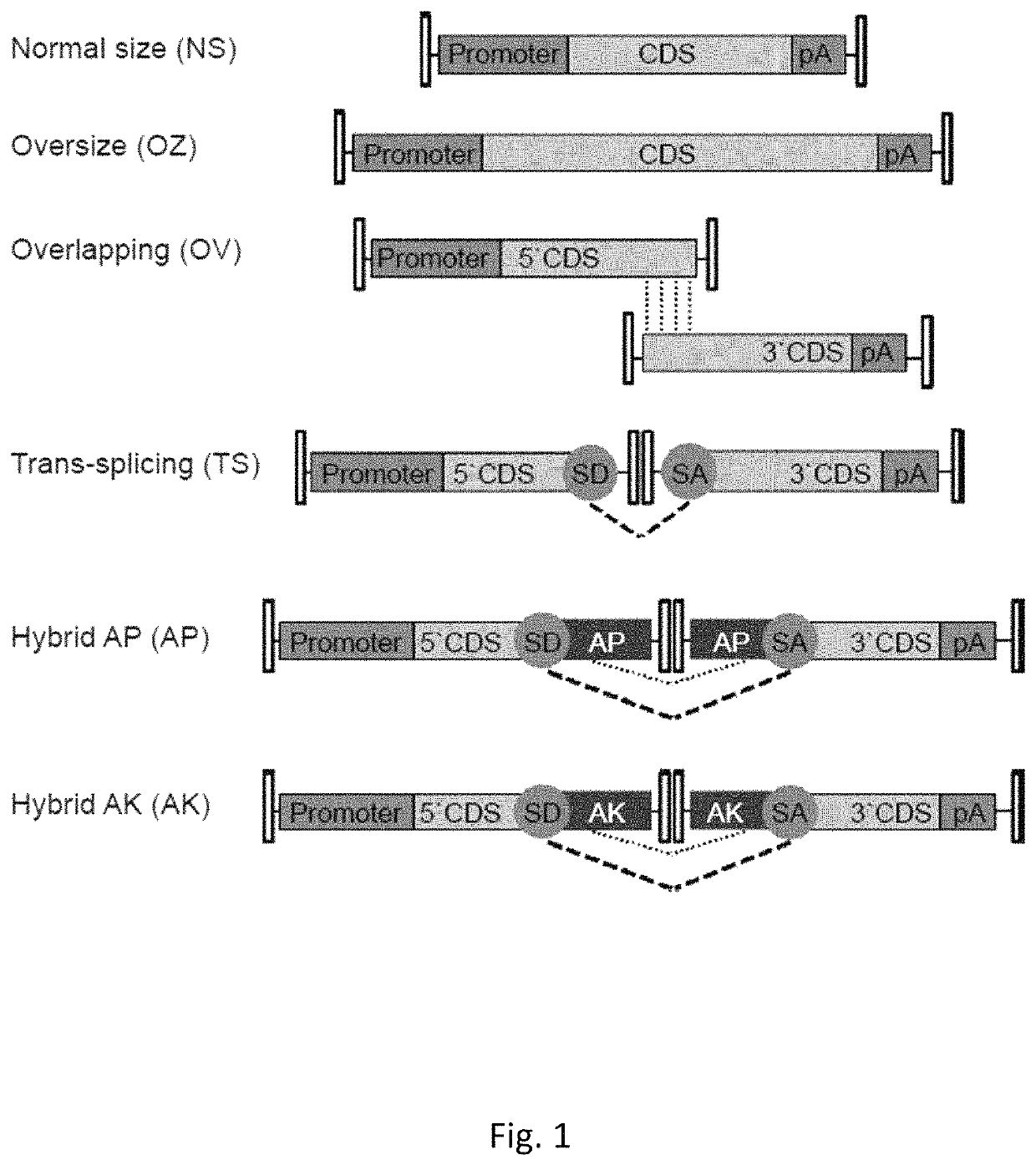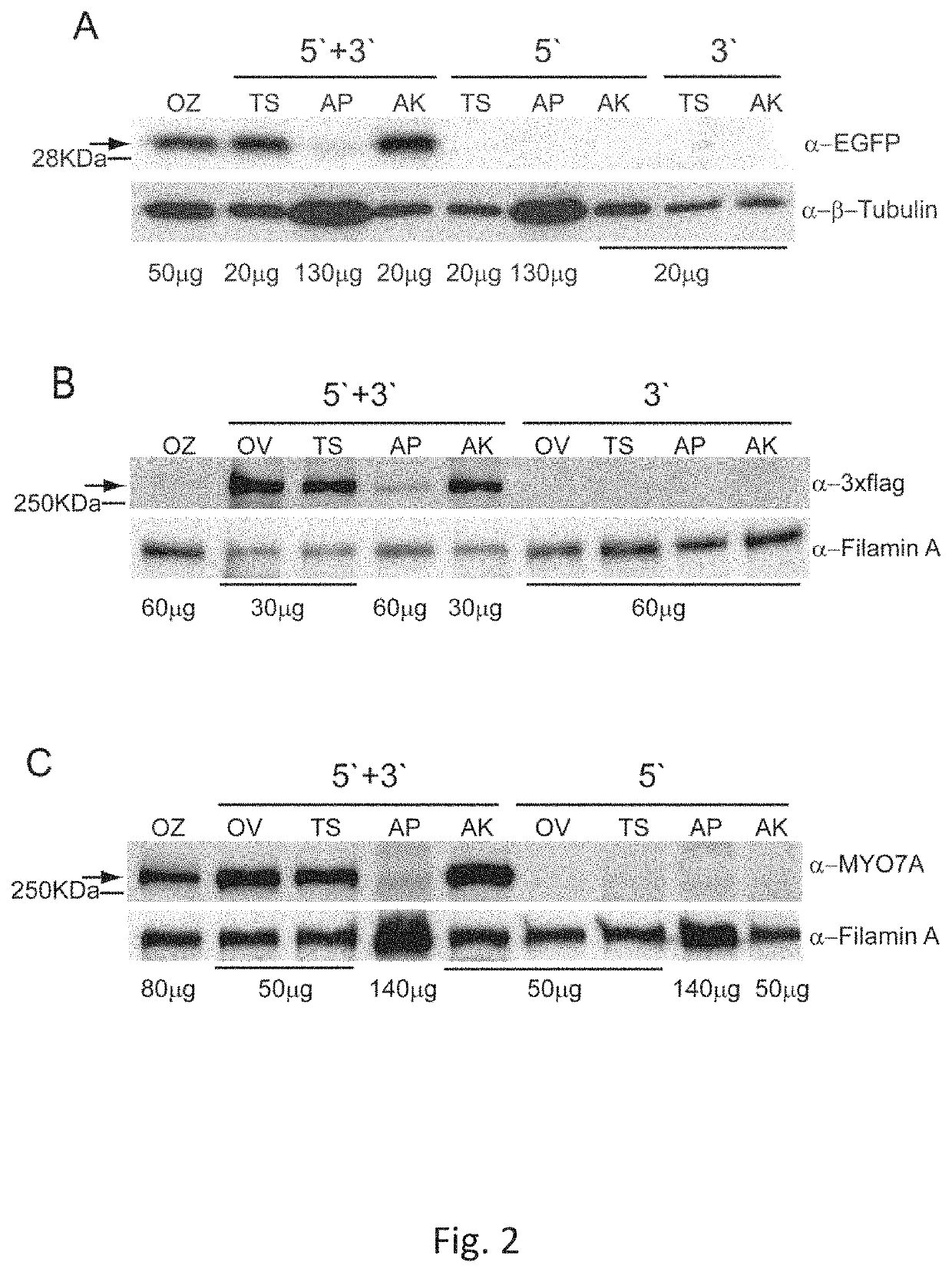Effective delivery of large genes by dual AAV vectors
a vector and gene technology, applied in the field of vectors, can solve the problems of limited to 5 kb, preventing the application of large gene transfer to therapies, and the packaging of large genes into aav capsids (oversize aav) may not be easily translated to the clinical arena, etc., to achieve the effect of enhancing the transduction rate of murine cells, improving the transduction rate of hepatocytes, and improving the effect of infectivity
- Summary
- Abstract
- Description
- Claims
- Application Information
AI Technical Summary
Benefits of technology
Problems solved by technology
Method used
Image
Examples
Embodiment Construction
Materials and Methods
Generation of AAV Vector Plasmids
[0132]The plasmids used for AAV vector production were derived from either the pZac2.1 (52) or pAAV2.1 (53) plasmids that contain the inverted terminal repeats (ITRs) of AAV serotype 2 (Table 1).
[0133]
TABLE 1Plasmids for AAV vector production.SizeAAV serotypePlasmidITR- ITR (bp)2 / 22 / 8Normal SizepZac2.1-CMV-EGFP-SV403006XX(NS)pZac2.1-RHO-EGFP-SV402900XOversizepAAV2.1-CMV-EGFP-9.9-BGH9951XX(OZ)pZac2.1-CMV-ABCA4_3xflag-SV408619XpAAV2.1-CBA-MYO7A_HA-BGH8220XOverlappingpZac2.1-CMV-ABCA4_5′4900XX(OV)pZac2.1-RHO-ABCA4_5′4805XpZac2.1-RHOK-ABCA4_5′4169XpZac2.1-VMD2-ABCA4_5′4658XpAAV2.1-CBA-MYO7A_5′4708XXpAAV2.1-RHO-MYO7A_5′4699XpZac2.1-ABCA4_3′_3xflag_SV404740XXpAAV2.1-MYO7A_3′_HA_BGH4655XXTrans-splicingpZac2.1-CMV-ABCA4 _5′TS4431X(TS)pZac2.1-RHO-ABCA4_ 5′TS4321XpZac2.1-ABCA4 _3′TS_3xflag_SV404587XXpAAV2.1-CBA-MYO7A _5′TS4468XXpAAV2.1-RHO-MYO7A _5′TS4459XpAAV2.1-MYO7A_3′TS_HA_BGH4298XXpZac2.1-CMV-EGFP_5′TS1906XXpZac2.1-RHO-EGFP_5′TS1802Xp...
PUM
| Property | Measurement | Unit |
|---|---|---|
| volume | aaaaa | aaaaa |
| volume | aaaaa | aaaaa |
| thick | aaaaa | aaaaa |
Abstract
Description
Claims
Application Information
 Login to View More
Login to View More - R&D
- Intellectual Property
- Life Sciences
- Materials
- Tech Scout
- Unparalleled Data Quality
- Higher Quality Content
- 60% Fewer Hallucinations
Browse by: Latest US Patents, China's latest patents, Technical Efficacy Thesaurus, Application Domain, Technology Topic, Popular Technical Reports.
© 2025 PatSnap. All rights reserved.Legal|Privacy policy|Modern Slavery Act Transparency Statement|Sitemap|About US| Contact US: help@patsnap.com



